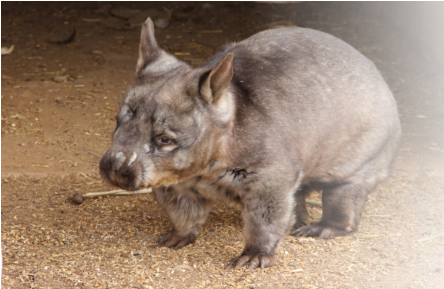


Southern Hairy Nosed
To some people the Southern Hairy-nosed Wombat may appear to
be a slow and bumbling animal, this is certainly not true. The
wombat is incredibly alert to the slightest sound or unusual scent
and When disturbed, it may run as fast as 40 km per hour over
short distance to evade its nemesis.Most wombats spend their day
underground inside a humid burrow and only come out in the
evening when the temperature and humidity are low enough so
that they do not lose to much water from their bodies due to
evaporation.Southern Hairy-nosed Wombats dig out lengthy and
extensive burrow systems, the entrances of which are usually
clustered to form a large central warren with smaller warrens
surrounding it at a radius of 100 to 150 m. Some times ten
wombats will live in a warren, and usually equal numbers of males
and females. Male wombats appear to stay at their home warren,
whereas females will reside in adjacent warrens for varying
periods. Aggression in wombats seems to be restricted to males
during the breeding season.Most wombat babies are born from late
September to December. The single baby remains in the mother's
pouch for six to nine months. Weaning occurs at about one year of
age, and both sexes mature at about three years of age.An increase
in the adult population of the Southern Hairy-nosed Wombat
requires three consecutive years of effective rainfall. This allows
females to provide milk, as well as for plentiful food to be
available at the time of weaning, and for good pasture at the time
of maximum growth for the young wombat



Southern Hairy Nosed
To some people the Southern Hairy-nosed
Wombat may appear to be a slow and
bumbling animal, this is certainly not true.
The wombat is incredibly alert to the
slightest sound or unusual scent and When
disturbed, it may run as fast as 40 km per
hour over short distance to evade its
nemesis.Most wombats spend their day
underground inside a humid burrow and
only come out in the evening when the
temperature and humidity are low enough
so that they do not lose to much water from
their bodies due to evaporation.Southern
Hairy-nosed Wombats dig out lengthy and
extensive burrow systems, the entrances of
which are usually clustered to form a large
central warren with smaller warrens
surrounding it at a radius of 100 to 150 m.
Some times ten wombats will live in a
warren, and usually equal numbers of males
and females. Male wombats appear to stay
at their home warren, whereas females will
reside in adjacent warrens for varying
periods. Aggression in wombats seems to be restricted to males
during the breeding season.Most wombat babies are born from late
September to December. The single baby remains in the mother's
pouch for six to nine months. Weaning occurs at about one year of
age, and both sexes mature at about three years of age.An increase
in the adult population of the Southern Hairy-nosed Wombat
requires three consecutive years of effective rainfall. This allows
females to provide milk, as well as for plentiful food to be
available at the time of weaning, and for good pasture at the time
of maximum growth for the young wombat
























































